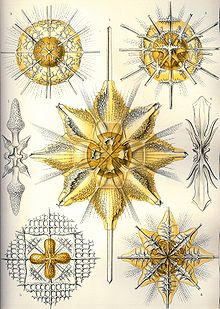Well, I don't want to worry you but there's some strontium very close by: in your bones, in fact (though I hope very much you're not going to have a chance to spot your bones except perhaps in an x-ray). As it happens the strontium in bones is very interesting because an analysis of it can give you an indication of where someone's lived.
So where can you spot strontium?
There's a lot of (non-radioactive) strontium in toothpaste for sensitive teeth, and also in the glass screens of old-fashioned cathode-ray TVs and monitors.
Acantharia, tiny protozoa that are found throughout the oceans of the world, make their skeletons of strontium sulphate. Acantharia are astonishingly beautiful, like living snowflakes,* though sadly they're almost too small (0.1 - 0.2 mm) to spot:

Strontium oxide is used to make glazes for pottery; strontium ranelate is used to treat osteoporosis; and strontium barium niobate is sometimes used to make holograms.
And those bright red fireworks? They're strontium, too.
The radioactive stuff, strontium 90, forms a part of nuclear waste. It's sometimes used in radiotherapy, and research is being done into using it in space ships and even cars.
Though personally, I have to say, given the choice I think I'd rather walk.
Spot the frippet: strontium. This element was named after the village of Strontian in Scotland, where it was discovered in 1790 by Adair Crawford and William Cruikshank.
*For all the pedants out there, yes, they do have the wrong number of points for snowflakes. Sorry.
No comments:
Post a Comment
All comments are very welcome, but please make them suitable for The Word Den's family audience.